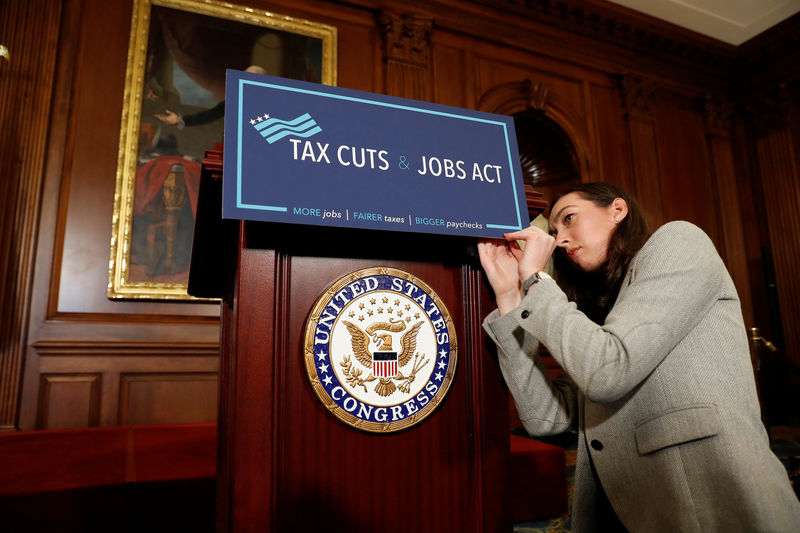 © Reuters. An aide adjusts a sign prior to a news conference announcing the passage of the “Tax Cuts and Jobs Act” at the U.S. Capitol in Washington
© Reuters. An aide adjusts a sign prior to a news conference announcing the passage of the “Tax Cuts and Jobs Act” at the U.S. Capitol in WashingtonBy Beth Pinsker
NEW YORK (Reuters) – At a retirement community near Chicago, Jay Schachner and his friends are nervously awaiting the fate of their medical expenses amid U.S. tax overhaul.
“Everyone is running scared, frankly,” said Schachner, an 86-year-old retired property law attorney who lives in a planned senior-living community in Chicago.
The U.S. House of Representatives voted in favor of a bill that would eliminate the deduction for medical expenses. The Senate version leaves it alone.
For most Americans, the medical deduction is currently available for expenses above 10 percent of adjusted gross income.
That is a pretty high bar for most people to clear, and only about 9 million claim it. Those who do are typically old, sick and not wealthy. About 75 percent of Americans who take the medical deduction are over 50, and 70 percent make $75,000 a year or less, according to AARP.
“It’s a very middle-income deduction,” said Cristina Martin Firvida, director of health security in AARP’s government affairs office.
For Schachner, the deduction for medical expenses provides a useful annual financial boost of several thousand dollars. The community where he lives is part of the Kendal system, a nonprofit continuing care retirement community. Residents pay an entry fee that averages around $250,000, along with monthly fees of about $3,000. A portion of those fees, from 20 percent to 30 percent, are counted as medical expenses that can be deducted.
Since the Schachners are spending down their nest egg, they are offsetting some of the tax bite from selling assets by taking a deduction for medical expenses. However, if the rules change and their calculations are off, they will have to scramble to make up the difference.
IMPACT ON PLANNED COMMUNITIES
Richard Garrison, a 71-year-old retired chemical engineer who lives in a Kendal property in Maryland, says that eliminating the medical deduction will be a killer for planned communities like his, where people sign up for a living arrangement that will carry them from independent apartments to nursing care.
Already more than 60 percent of Social Security beneficiaries receive at least half their income from Social Security, according to the Social Security Administration. Those that completely run out of options end up on Medicaid, the social safety net that ends up paying for a lot of end-of-life care.
Just 1 percent of Kendal’s 13 affiliates transition to Medicaid now, said Marvell Adams, executive director of the Collington Community, a Kendal affiliate.
Another snowball factor of eliminating the medical deduction starts with seniors who suddenly have to cover several thousand dollars more in medical expenses a year. They will have to draw down more of their savings to cover those costs, putting them in danger of running out of money faster.
And the more they withdraw from their saving in a year, the more their Social Security benefits become taxable.
“It’s a double hit to a lot of these folks,” said John Dundon, a tax accountant and enrolled agent from Denver.
Dire medical conditions also take a tax toll on pre-retirees. Jennifer MacMillan, a tax accountant in Santa Barbara, California, has a client who is in her 60s and still working, making $120,000 a year. Her husband has Alzheimer’s, and the annual cost for him to live in a facility is $60,000.
With big medical expenses since 2015, she ended up with very little tax and got a refund, MacMillan said.
“Without that deduction, for anyone with a family member with a serious illness, it will be devastating,” she added.
Source: Investing.com





























